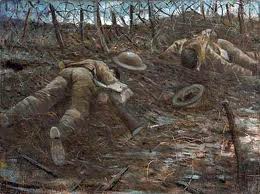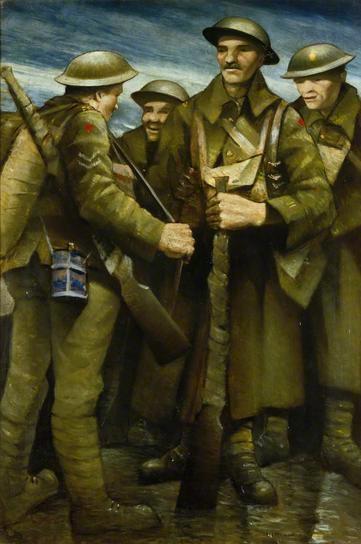Paths of Glory (painting)
Date: 1918
Region: Europe
Subject: Political/Economic/Social Opinion
Medium: Painting
Artist: Christopher Richard Wynne Nevinson
Confronting Bodies: British Government
Date of Action: March 1918
Location: London, England
Description of Artwork: Nevinson's painting Paths of Glory is "brown and green oil on canvas depict[ing] two dead British soldiers sprawled on a hillside littered with rifles, helmets, and barbed wire. The soldiers appear, compositionally, to recede from the lower left to the upper right of the canvas. Unlike Returning to the Trenches, in which military might is suggested by an infinitely long line of marching men, Paths of Glory portrays the human cost of war, with a recessive line implying an untold number of dead beyond the limits of the canvas. A mood of morbidity and death is heightened through use of eerie, unnatural light that casts aqua-colored shadows across the dead soldiers and the debris that surrounds them. The small sone of background sky is transected by a skeletal web of posts and barbed wire, and appears only at the very top of the composition, conveying a sense of restriction, rather than liberation." This painting was part of a series of 75 paintings, drawings and prints that Nevinson completed after his return from France and Belgium where he had been sent by the British government as an official war artist on July 5, 1917.
The Incident: Working as a volunteer ambulance driver on the western front from 1914-15, Nevinson's work focused upon the visual realities of war. In the following years he became an official wartime artist for the British government, during which time he was often sent off to the front lines, and upon return would produce pictures from his experiences which the government then had the option of buying from him for use in propaganda material, or leaving unbought images as property of the artist. At the time that his works were being reviewed by the government, two paintings, Paths of Glory and A Group of Soldiers, were officially deemed 'hindrances to the war effort'. A Group of Soldiers was "suppressed because of it's purportedly unflattering representation of British soldiers, who were thought to resemble mannequins or ventriloquist's dummies", however, in the end it was decided that the image should "only be censored 'from a military point of view, not an aesthetic one'" and was ultimately approved for exhibition and reproduction in December of 1917. Paths of Glory remained a censored image, though the reasoning behind this is still unclear. The explanation given by the government at the time was that the image of dead British soldiers would undermine the public morale at a time during the war when morale was already at an all time low. However the numerous other exhibitions around London at that time portraying dead soldiers, both Allied and enemy soldiers, is inconsistent with that reasoning. There were also a number of war photographers who's images were equally if not more graphic showing frequently in London as well. One possible explanation for this double standard is that the government at the time considered photographs to be merely records of events as opposed to works of art, and therefore intention and effect were not critiqued in the same manner. Another possibility for the controversy surrounding this painting was actually the title, Paths of Glory. It has been proffered that perhaps the most popular poem in the English language, and certainly the most popular at the time, was Thomas Gray's poem Elegy Written in a Country Churchyard, wherein the ninth stanza contains the line, "The paths of glory lead but to the grave." This poem was apparently a common source of support for the war ridden public during this low point. Regardless of the immediate reasoning, the government did purchase the painting, supposedly to control it¹s display, but it was left in Nevinson's possession. Nevinson included it in his one-man show at the Leicester Galleries, London in March of 1918. On later accounts he states that it was included that the controversy would die down prior to the shows opening. When this failed to happen, rather than remove it from the wall, he hung a large banner diagonally across it which read, "CENSORED."
Results of Incident: Nevinson's painting was successfully kept out of the newspapers and periodicals; the only reproductions allowed were those photographs with the 'censored' banner covering it. However, it was never destroyed or painted over, and now hangs permanently in the Imperial War Museum, London.
Source: "Art Journal", v51 p22-91, Spring 92

